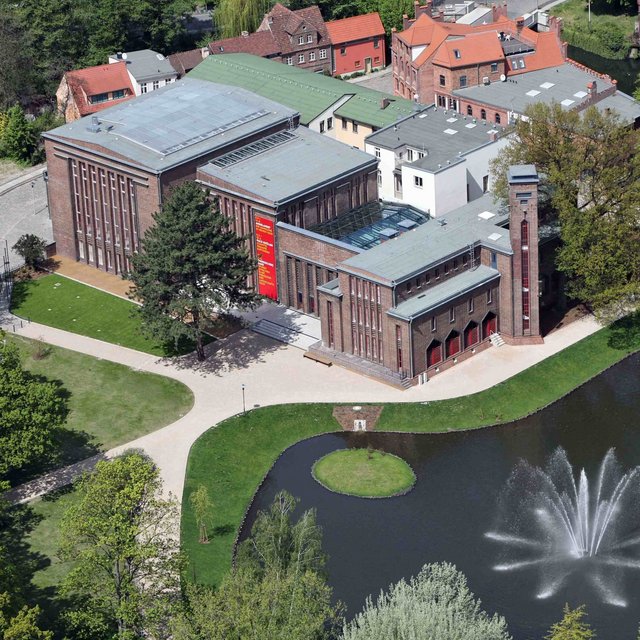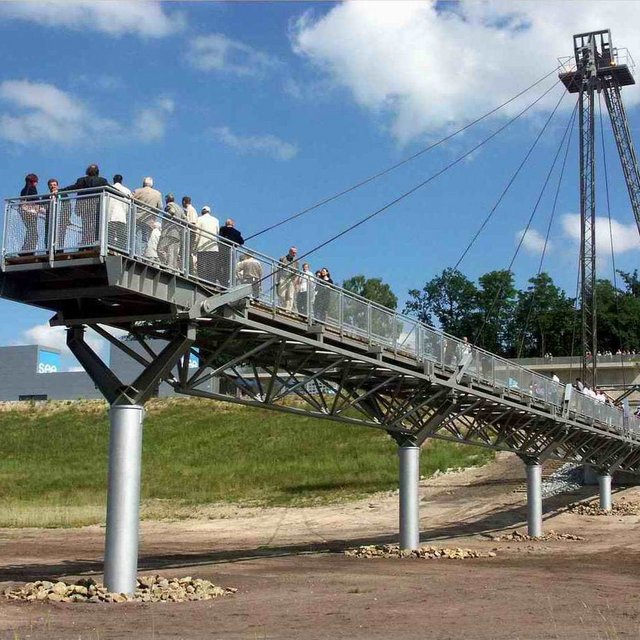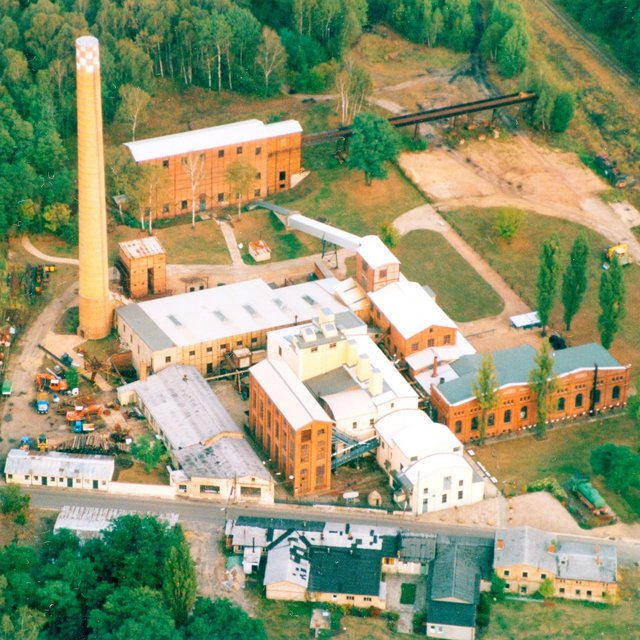Regional route Lusatia | Germany
Lusatia is swimming in a sea of lignite. Over decades the area between the Elster, Spree und Neisse rivers was transformed into a centre for the power industry by opencast pits, briquette factories and power stations. Visitors were few and far between. Today, however, they are streaming in – on the trail ... more
ENERGY The Lusatian Route of Industrial Heritage
Lusatia is swimming in a sea of lignite. Over decades the area between the Elster, Spree und Neisse rivers was transformed into a centre for the power industry by opencast pits, briquette factories and power stations. Visitors were few and far between. Today, however, they are streaming in – on the trail of an industrial past which, in many places, is now a living present. The Lusatian Industrial Heritage ENERGY Route, an Internationale Bauausstellung (IBA) Fürst-Pückler-Land project, takes in outstanding examples of 150 years of industrial tradition.
This tradition is evident in the very places where, at first sight, there appears to be nothing of note. The Pritzen bell tower is just such a place. It actually belongs to Wolkenberg, but the Welzow-Süd lignite pit is now situated where the village used to be. A campaign was launched to save the bell tower and it was rebuilt on the spot where Pritzen village church once stood. This in turn was given a new home in Spremberg. Originally, Pritzen was also earmarked for lignite production and large areas were laid waste, but part of it was eventually spared – just a few metres away from the abyss of the former Greifenhain opencast mine.
The coal gives and the coal takes away, say the people of Lusatia. They do indeed live in a landscape which is literally moving. That hasn’t always been the case. Lignite had precious little significance 200 years ago. Initially it was extracted from open pits at a few, mostly very small, mines and later from below the surface in so-called pillar burst mines. It was used primarily for small brickworks and distilleries, but was then found to be useful in road-building and ground improvement in agriculture. Its importance grew apace with industrialisation, which started comparatively late in Lusatia. Energy requirements were increasing in leaps and bounds, particularly in the rapidly developing textile industry, although the kilns of the up-and-coming Lusatian glass industry also benefited from local fuel.
By the turn of the 20th century the original tunnel mines had reached their limits and were no longer able to meet the growing demand for lignite. The future belonged to the expanses of opencast mines that were now opening up everywhere, and the dimensions of which have continually increased over the course of time. The world’s first overburden conveyor bridge was installed at the "Agnes" mine near Plessa as early as 1924, finally completing the breakthrough in modern Lusatian lignite mining. Unprecedented large-scale production techniques, which have remained a feature of the Lusatian and central German mining district, brought about a significant increase in the quantities processed. Much-wanted fuel came from lignite: power generation on a large scale for industrial and domestic use and, not least, a raw material for the chemical industry.
From then on the face of Lusatia was radically changed. By the middle of the 1990s surface mines had ravaged around 80,000 hectares – an area roughly the size of the city of Hamburg. At the same time, millions upon millions of cubic metres of groundwater had to be pumped out to get to the coal seams, some of which lay deep underground. The result of this Herculean task: around 200 million tonnes of pit lignite a year.
Behind these dry statistics lies the history of an entire region, mirrored in umpteen thousand biographies full of vision and personal sacrifices – sometimes decreed by the state. Since the early 1960s alone, more than 80 villages and districts have disappeared into the insatiable jaws of the mines. As a consequence, 26,000 people lost their homes and were moved into one of the new concrete housing estates. These were bursting at the seams and yet lignite, the backbone of the GDR economy, drew more and more workers. Hoyerswerda, for instance, the "2nd socialist city", grew from 7,000 to 77,000 inhabitants in less than 30 years. Industrial plants, in many ways interdependent, created incomes for many people. There was modern housing, improved living conditions and a sense of being at the heart of change. This brought the promise of completely new perspectives to an area which, for centuries, had been first and foremost rural.
In 1957, the entire region around Cottbus was declared an "energy district". Local mining technology – together with the smoking chimneys of Lusatian power stations, coking plants and briquette factories – meant that the GDR could reliably meet its own energy needs and, more than anything else, symbolised pride in its own achievements. The "Winterschlachten" (winter battles), in which friends, students, teams of Lusatian workers, and even prisoners and NVA soldiers laboured together to stop the Republic from freezing and the lights going out, are still legendary today.
The flip side of this power industry at any price was a national economic and ecological disaster. As elsewhere, disillusionment came with reunification. Entire industrial complexes proved unprofitable in a market economy and were phased out. The number of employed people fell equally dramatically. Many who had belonged to the working elite now became welfare cases. The Cottbus area was not spared from the general misery: more or less overnight large areas of the one-time energy centre of the GDR were classed as ecological disaster zones.
Four opencast mines are still operating in Lusatia at the present time, with a fifth preparing to go back into service. Nearly all the chimneys have disappeared. This helps the environment, but threatens to obliterate parts of a past that has left an enduring mark on the people and their region.
From the outset, part of this past was the attempt to make exhausted coal pits blend back into the natural landscape and be of some use. This kind of large-scale remodelling of the landscape has a distinguished ancestor in Lusatia: in the 19th century, Prince Hermann Heinrich of Pückler-Muskau had lakes and canals dug out, hills landscaped and trees planted in his parks in Muskau and Branitz, which were renowned far and wide. Today he is the named patron of the Internationale Bauausstellung (IBA) FürstPückler-Land, which, since 2000, has been playing an active role in structural change in Lusatia and will continue to do so until 2010. It is keen for the theme of "landscape" to be the focus of its work and is behind the push to shift mine waste and create new lakes. This is meant quite literally – the remains of no less than 20 former open pits are currently being flooded. Within just a few years they are expected to have formed Europe’s largest artificial chain of lakes, the Lusatian Lakeland.
Casting, rehearsal, production: these are the means by which the IBA projects, 25 in total, give forward-moving impetus, the aim being to preserve industrial structures, large-scale machinery and workers’ settlements and, at the same time, to make them into suitably interesting places of industrial heritage for the future. This is an unusual vision for Lusatians. They could not have imagined at the start that something like an opencast mine – the dirt hole, as they called it – could be a tourist attraction. The growing feedback from visitors has long since convinced them otherwise, and breathed far greater life into their cooperation with the IBAs work.
The route
Brought into being in 2006, the "Lusatian Industrial Heritage ENERGY Route" is a new attraction for tourists. It is a richly varied theme tour bringing together outstanding industrial sites. The spectrum ranges from the "horizontal Eiffel Tower", as the colossal F60 overburden conveyor bridge in Lichterfeld is called, and the sensational bio-towers of the former Lauchhammer coking plants and the impressive Lusatian mining museum in a former briquette factory in Knappenrode. An ideal starting point for the route is the IBA Terraces in Großräschen, where there is a display of all the IBA projects at the Internationale Bauausstellung visitor centre, and alternating exhibitions introducing visitors to the history and perspectives of the mining region of Lusatia.
The ENERGY route runs through parts of Lusatia situated in the federal states of Brandenburg and Saxony and is a flagship initiative for the "Lusatian industrial heritage" brand. This brand is being developed and marketed by the "Lusatian strategy group", consisting of Brandenburg tourism associations and marketing organisations from Lower Lusatia, Elbe-Elster-Land, Spreewald and Cottbus, as well as the Saxon marketing company for Upper Lusatia-Lower Silesia and the regional management of Lusatia-Spreewald and Lusatia (Upper Lusatia).
Related links

ERIH Anchor Points
Saxon Museum of Industry | Knappenrode Energy Factory
Ernst-Thälmann-Straße 8
02977
Hoyerswerda, Germany
F60 Overburden Conveyer Bridge
Bergheider Straße 4
03238
Lichterfeld, Germany
Sites
Brandenburg State Museum of Modern Art, Diesel Power Plant
Uferstraße / Am Amtsteich 15
03046
Cottbus, Germany
Margarethenhütte Museum of Electric Porcelain
Hermann-Schomburg-Str. 6
02694
Großdubrau, Germany
IBA-Terraces Lausitzer Seenland visitor centre / former Meuro opencast mining
Seestraße 100
01983
Großräschen, Germany
Lauchhammer Bio-Towers
Finsterwalder Str. 57
01979
Lauchhammer, Germany
Marga Garden City
NL-Kunstschule "Birkchen" e.V.
Straße der Jugend 1a
01968
Senftenberg, Germany
Louise Briquette Works
Louise 111
04924
Uebigau-Wahrenbrück, Germany









